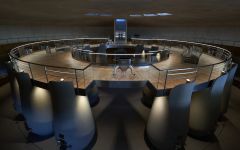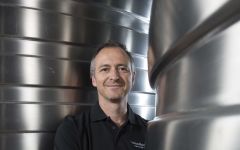Chateau Haut-Bailly 2008
-
Robert
Parker -
Jeb
Dunnuck - Decanter
-
Wine
Enthusiast -
James
Suckling -
Wine
Spectator




Product Details
Your Rating
Somm Note
Winemaker Notes
Low yields and a late year are a strong indication of excellent quality. The 2008 vintage is rich in color, has great vivacity, structure and balance, with velvety tannins that are seductive and powerful: both striking and soft!
Professional Ratings
-
Robert Parker's Wine Advocate
A candidate for the -wine of the vintage,- the 2008 Haut-Bailly possesses incredible complexity. Tell-tale notes of lead pencil shavings, charcoal, damp earth, black cherries and black currants intermixed with a hint of subtle barbecue smoke are present in this classic, quintessential Graves. Medium-bodied with an emerging, precocious complexity, it is a super-pure, beautifully textured, long wine that can be drunk now or cellared for 20-25 years. Bravo!
-
Jeb Dunnuck
Fully mature, yet still pure and layered, with plenty of vibrancy, the 2008 Château Haut-Bailly has quintessential Haut-Bailly sweet darker berries, smoked tobacco, minty herbs, and floral aromas and flavors. These carry over to the palate, where the wine is medium to full-bodied, has firmer, focusing tannins, solid mid-palate depth, and a great finish.
-
Decanter
Beautifully balanced and concentrated, with Cabernet Sauvignon dominant in the fruit expression in terms of the controlled, elegant, savoury and totally moreish blackberry and cassis fruits. This remains extremely young, closed in on itself, not quite ready to reveal all its facets, but has the grip that suggests just how good this wine is, finishing up with layers of plum, slate and liquorice. Particularly late harvest in 2008 right through to October 23 (beginning September 25), one of the latest on record, and the latest of the decade. Highlights how sure and confident was the winemaking at Haut-Bailly ten years on from Bob Wilmers arrival. Drinking Window 2020 - 2040
-
Wine Enthusiast
While at this young stage there may be toasty aromas, there is also intense, perfumed fruit. This complex, distinguished wine is polished, with plenty of bright fruits and acidity.
-
James Suckling
Wonderful nose of decadent fruit and chocolate, with hints of meat and flowers. Full bodied, with well-integrated tannins and a spicy, silky and long finish. Tight now, but so fine and dense. Give it four to five years of bottle age. So lovely. Best after 2013.
-
Wine Spectator
Racy and slightly taut, with red currant and cherry pit notes laced with grilled herb and warm stone. There’s a sinewy edge on the finish, with more minerality than fruit for now, but this adds some flesh as it airs, showing subtle persistence. Drink now through 2016.
Other Vintages
2022-
Jeb
Dunnuck -
James
Suckling -
Robert
Parker - Decanter
-
James
Suckling - Decanter
-
Robert
Parker -
Jeb
Dunnuck
-
James
Suckling -
Jeb
Dunnuck -
Wine
Enthusiast -
Robert
Parker -
Wine
Spectator - Decanter
-
James
Suckling -
Wilfred
Wong - Decanter
-
Wine
Enthusiast -
Jeb
Dunnuck -
Robert
Parker
-
James
Suckling -
Jeb
Dunnuck - Decanter
-
Robert
Parker -
Wine
Enthusiast -
Wine
Spectator
-
Robert
Parker -
Jeb
Dunnuck - Decanter
-
James
Suckling -
Wine
Enthusiast -
Wine
Spectator
-
Robert
Parker -
Jeb
Dunnuck -
James
Suckling - Decanter
-
Wine
Enthusiast -
Wine
Spectator -
Connoisseurs'
Guide
-
James
Suckling - Decanter
-
Jeb
Dunnuck -
Wine
Enthusiast -
Robert
Parker -
Wine
Spectator
-
Wilfred
Wong -
James
Suckling -
Wine
Enthusiast -
Jeb
Dunnuck - Decanter
-
Wine
Spectator -
Robert
Parker
-
Jeb
Dunnuck -
Wilfred
Wong -
Wine
Enthusiast -
James
Suckling -
Robert
Parker -
Wine
Spectator
- Decanter
-
Wine
Enthusiast -
Robert
Parker -
James
Suckling -
Jeb
Dunnuck -
Wine
Spectator
-
Jeb
Dunnuck - Decanter
-
James
Suckling -
Wilfred
Wong -
Wine
Enthusiast -
Robert
Parker -
Wine
Spectator
-
Jeb
Dunnuck -
Robert
Parker - Decanter
-
James
Suckling -
Wine
Enthusiast -
Wine
Spectator
- Decanter
-
Robert
Parker -
Jeb
Dunnuck -
Wine
Spectator
-
Jeb
Dunnuck - Decanter
-
Wine
Spectator -
Robert
Parker -
James
Suckling -
Wine
Enthusiast -
Connoisseurs'
Guide
- Decanter
-
Robert
Parker -
Wine
Enthusiast -
Jeb
Dunnuck -
Wine &
Spirits -
Wine
Spectator -
James
Suckling
-
James
Suckling - Decanter
-
Jeb
Dunnuck -
Robert
Parker
- Decanter
-
Jeb
Dunnuck -
Robert
Parker







The vineyard of Haut-Bailly as we know it today began to take shape when the Goyanèche and then the Daitze family acquired and unified the best vine growing plots in the 1530s. The estate remained in the Daitze Family until 1630 when it was purchased by Firmin Le Bailly and Nicolas de Leuvarde, wealthy Parisian bankers and lovers of Graves wines.
Following substantial investments, the property continued to be passed down the Bailly family line until 1736, when Irishman Thomas Barton took the helm. His strong business network allowed him to spread word about the quality of Chateau Haut-Bailly at a time when French ‘claret' was beginning its rise to stardom in England and Ireland.
Throughout the 18th century powerful, well-connected and ambitious owners drove Haut-Bailly to new heights, including Christophe Lafaurie de Monbadon and his son Laurent who went on to become Mayor of Bordeaux in 1805.
In 1872, Alcide Bellot des Minières acquired the estate and constructed the imposing, stone chateau building that remains to this day. He pioneered a precise, science-driven approach to viticulture, becoming a figure of legend widely known as the 'King of Vintners'. Thanks to Alcide's incredible drive, Haut-Bailly experienced a remarkable golden age, commanding the same prices as the First Growths: Lafite, Latour, Margaux and Haut-Brion.
The purchase of Haut-Bailly in 1955 by Daniel Sanders, a Belgian negociant, opened up a new era. Daniel and his son, Jean, recomposed the vineyard, renovated the winery and took pains to select only grapes from the best vines for their grand vin. They succeeded in giving the wines a unique style and reputation, and Haut-Bailly recovered its image as a great wine on the international marketplace.
In July 1998 Chateau Haut-Bailly was purchased by American Robert G. Wilmers, chairman and CEO of the M&T Bank based in Buffalo, New York. A lifelong lover of Bordeaux Grands Crus, Bob was behind every strategic decision, ensuring that Haut-Bailly followed a path of progression and continuity whilst remaining ever-respectful of its heritage.
After Mr. Wilmers purchased the property, he first asked Jean Sanders to stay on board, and then Véronique Sanders, fourth generation, to serve as general manager, overseeing a far-reaching investment programme to modernise the vineyards, cellars, offices, and chateau itself.
For Bob and his wife Elisabeth, Haut-Bailly went well beyond a financial investment: it was a joint passion. Following the sad passing of Bob in December 2017, his family has taken over and will continue in his footsteps. Together with the management team, they are committed to continuing Bob’s work in the same spirit and energy as in the past twenty years. The many recently initiated and future projects will be pursued.
With the 2021 vintage, Chateau Haut-Bailly debuted a contemporary, custom-built winery which was completed at the end of 2020. The building allows them to carry out precision work in optimal conditions thanks to the space, natural light and technical innovation which are at the heart of the project.

One of the world’s most classic and popular styles of red wine, Bordeaux-inspired blends have spread from their homeland in France to nearly every corner of the New World. Typically based on either Cabernet Sauvignon or Merlot and supported by Cabernet Franc, Malbec and Petit Verdot, the best of these are densely hued, fragrant, full of fruit and boast a structure that begs for cellar time. Somm Secret—Blends from Bordeaux are generally earthier compared to those from the New World, which tend to be fruit-dominant.

Recognized for its superior reds as well as whites, Pessac-Léognan on the Left Bank claims classified growths for both—making it quite unique in comparison to its neighboring Médoc properties.
Pessac’s Chateau Haut-Brion, the only first growth located outside of the Médoc, is said to have been the first to conceptualize fine red wine in Bordeaux back in the late 1600s. The estate, along with its high-esteemed neighbors, La Mission Haut-Brion, Les Carmes Haut-Brion, Pique-Caillou and Chateau Pape-Clément are today all but enveloped by the city of Bordeaux. The rest of the vineyards of Pessac-Léognan are in clearings of heavily forested area or abutting dense suburbs.
Arid sand and gravel on top of clay and limestone make the area unique and conducive to growing Sémillon and Sauvignon blanc as well as the grapes in the usual Left Bank red recipe: Cabernet Sauvignon, Merlot, Cabernet Franc and miniscule percentages of Petit Verdot and Malbec.
The best reds will show great force and finesse with inky blue and black fruit, mushroom, forest, tobacco, iodine and a smooth and intriguing texture.
Its best whites show complexity, longevity and no lack of exotic twists on citrus, tropical and stone fruit with pronounced floral and spice characteristics.
